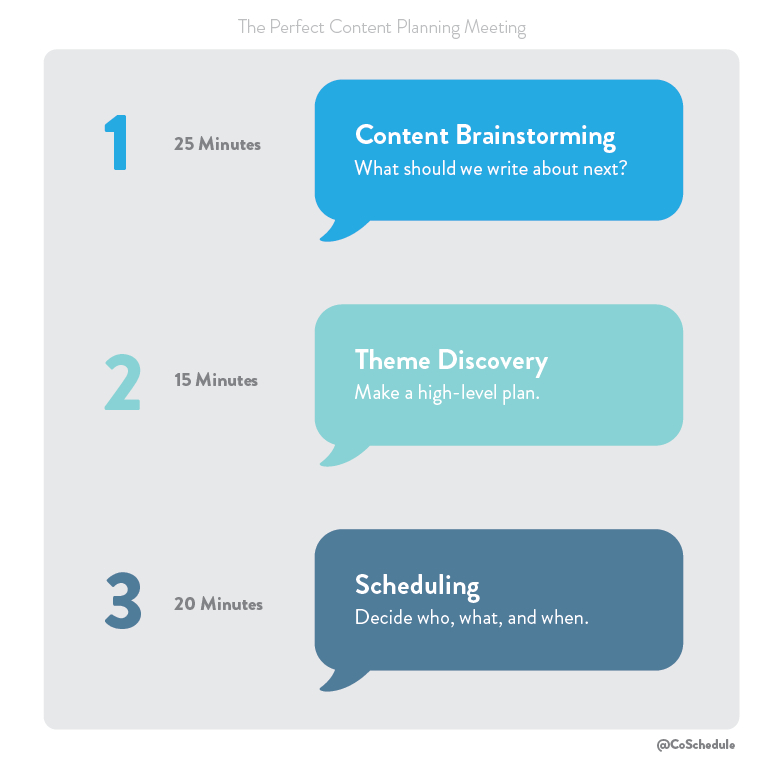As a content marketing company, the CoSchedule team is constantly trying to find ways to help our customers save time and streamline their marketing process.
It’s not always easy. Content marketing teams have a lot to think about. For example…
- Is my headline touching on all the right emotions?
- How long should our content really be?
- How can we streamline our process and create better content in half the time?
As a part of our ongoing customer research, we’ve talked to hundreds of bloggers and content marketing teams, observing them directly in their element. We’ve seen ‘how content marketing is made,’ so to speak, and we’ve observed some highly-productive teams in action.
That’s what this post is all about. It’s about streamlining your content marketing process so that it is fast, efficient, and constantly churning out awesome content that your readers will love and share.
These are our best tips, so ignore them at your own risk :).
Download this free content promoting checklist to drive more traffic to the content you create.
1. Set clear expectations for everyone on the team
The best functioning teams have clearly defined roles and expectations for everyone on the team. This is true for the small 1-2 person teams, and the 20+ publishing powerhouse. Everyone knows their role and how they fit in. The biggest difference between a smaller team and a larger team is simply how broadly those roles are defined.
The idea here is to break down the workload into understandable roles that can be delegated to experts in each discipline. For example, on our team we have several roles that are regularly filled:
- Blog Manager: Chooses topics, and guides articles in the right direction.
- Staff Writer: Responsible for writing and creating content. These folks love to write!
- Guest Contributors: Occasional writers that add a unique and outside perspective.
- Copy Editor: A role reserved for our lead writer who reviews all content for best practices in grammar, spelling, writing, and style.
- Social Media Manager: Responsible for scheduling and maintaining our social media calendar and promoting our content across our social channels.
- Graphic Designer: Responsible for creating graphics as needed for the blog.
It is important to realize that many of our team members cover multiple roles on this list, but that doesn’t make it any less valuable to define them upfront. As that team member moves through the process, they can simply wear a different metaphorical hat as they work through the process.
2. Define your process, and make sure everyone understands it
In addition to defining roles, you will also need to implement a structured process that will be carried out for each new piece of content created. This is basically the step-by-step process that will outline who will do what, and when they will do it by. Think of it as the to-do list for each post that you create.
While many of us are appropriately averse to over-organization, setting a clear process will no doubt make your team more efficient and streamlined. When everyone knows what to do now and what to do next, the process will continue to move forward. When questions and doubt exist, that same process will come to a screeching halt, resulting in lost time.
The threat here is a team member or set of team members that regularly exempt themselves from this process. This creates more inefficiency and will hurt your team. Make sure everyone is participating in the same process and knows how it works.
3. Don’t rely on already-bloated channels for communication
I once conducted a call with a marketing team that did all of their content scheduling and communication over email. By the end of a normal week, the team would frequently have email threads that were 40-60 emails deep. It was a nightmare.
Put simply, email inboxes are bloated. It just isn’t where productive conversations belong anymore. If you’re relying on it, you’re adding inefficiency to your process.
You need to find a way to add context to your communication. Let me give you an example.
About a year ago, our own team switched over from Skype to a team chat tool called HipChat to handle our intraoffice discussion. The change was an immediate relief.
HipChat allowed our team to create separate “rooms” around certain topics in our office. For example, we have a room exclusively for the CoSchedule marketing team. These “rooms” add context to our discussion. We all know that conversation in that room will be about marketing. Plus, only the marketing team is informed of the discussion, so no one else is distracted.
The same can be said for other tools that focus on streamlining the content marketing process. CoSchedule is a great example of this for WordPress, but other tools like Basecamp and HipChat can help add the necessary level of context to your work.
Don’t rely on email. Find another tool to facilitate the communication that you need on your team.
4. Use weekly touchpoints to stay focused on the same goals
At CoSchedule, our primary job is to build web-based software. For this, we use an Agile Software method that focuses on face-to-face communication and evolutionary planning rather than a set-in-stone product roadmap.
This means that we meet (for a short time) daily to make changes to our plan and adapt to our circumstances. Agile proposes that continuous communication and adjustments provide better results than a strictly-followed strategy. The content marketing team can benefit from the same approach.
We frequently hear about high-producing content marketing teams taking weekly, if not daily, time out of their schedule to meet together face-to-face and conduct a content planning meeting.
The purpose of these meetings is simple. Teams work better when they understand their collective purpose and message. We frequently see these meetings broken down into three chunks: content brainstorming, theme discovery, and editorial scheduling.
This step is really about creating focus among the team. A lack of focus creates randomness, which leads to major inefficiency. Regular content planning meetings will add the necessary focus to the team.
In the Agile process, our developers frequently share tips, tricks, and learned best practices in their meetings. This ensures that everyone on the team is creating amazing content, and working toward a common goal.
Again, it’s about focus. Just remember that focus equals efficiency.
5. Plan your content on an editorial calendar
Of course, we talk to a lot of teams that use an editorial calendar. The great thing is that it is part of what makes them so productive.
At CoSchedule, our users regularly tell us that they create more content and get more traffic simply by adding an editorial calendar to their process. That’s great news considering how this is something that isn’t difficult to put into place. There are plenty of templates out there that are completely free.
This really comes back to focus and intentionality.
When we put something on the calendar, we are immediately more likely to get it done. Even though it is really just a soft commitment, the calendar gives us a plan to follow. When the time comes, we don’t have to figure out what to write, we simply write what is scheduled to be written. This reduces the barrier to entry and makes us more likely to get the writing done.
Adding a yearly, monthly, and weekly content marketing editorial calendar is a great way to simplify and streamline your process.
6. Get the most out of the content you already have
In content marketing, we can easily believe that more is better, a trap many bloggers fall into. After all, if we get an average of 500 visits for each post that we publish, an obvious way to double our traffic would be to simply double the number of articles that we post.
But, wouldn’t you be better off getting more distance out of the content that you’ve already written? What would happen if you spend the time that you would usually spend writing a new post by re-promoting an old one instead?
There are four primary ways that product teams can get this done.
- They have a high-frequency sharing schedule for their content. Rather than just sharing something on social media once, they do it over and over again, making sure that their audience has every opportunity to see it without spamming.
- They have an amazing email marketing program that brings them constant traffic. If you aren’t building this already, you need to start now.
- They are amazing at repurposing their content for other sites. This could be as simple as remixing a post to share on another blog or recreating it as another piece of content entirely, such as a slideshow, video, or recorded podcast.
- They are dedicating time to both blog promotion and good PR. It takes a lot of time and energy to create great content, and if you aren’t spending enough time promoting it, you aren’t giving it the chance that you deserve. The best of the best spend just as much time promoting their content as they do create it.
The point is that smart teams make sure their content goes the distance, and that is a big part of what makes them so efficient.
—

Content marketing as a tactic for company growth is big and growing bigger. We constantly need to be looking to the best in the field for advice and tips on how to pull it off and streamline our process at the same time. These tips are the tried and true methods that we have seen work over and over again.
We will be profiling some great teams on our own blog, digging into the process that they use day after day. Be sure to check it out, if you really want to see “how content marketing is made.









